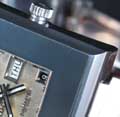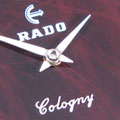RADO Watches

| Brand: | Rado |
| Model: | Diastar 54 |
| Ref.: | 680.0054.3 |
| Issued: | 1977 |
| Case: | Tungsten-carbide with steel snap-back |
| Bracelet: | Stainless steel, mfd. by NSA, reference unknown |
| Movement: | Rado Cal. 680 (A. Schild 5008) 25j alarm with day/date, gilt |
Description: Following in the footsteps of their first automatic alarm watch Rado combined its mechanical functions with their successful scratchproof tungsten-carbide technology to produce the Diastar 54 alarm. Its design combines elements of the barrel shapes seen on the cases of both predecessor models with a very legible argent dial. The rotating anchor symbol and red-tipped alarm indicator offer subtle splashes of color. A tapered bracelet of alternating polished and textured peaked links was original to this model. The spring-loaded extension clasp is signed RADO on top and NSA on the underside. As with the steel-cased automatic alarm, only 1000 examples of this reference were made; production ran from 1977 to 1980.
Data (courtesy Rado Watch Co.):
| Ref. 680.0054.3 |
| Made from 1977 to 1980 |
| 1,000 units produced |
| Rado Cal. 680 (A. Schild Cal. 5008, 13.25 ligne, Day-Date, 4 hands) |
| Original price: CHF 1,065 |
Photos: Click for larger images
This watch has been sold.


Brand: Rado
Model: Diastar 14
Ref.: 14
Issued: 1972
Case: Tungsten-Carbide bezel, stainless steel back
Crystal: Flat Sapphire
Bracelet: n/a
Movement: ETA 2789, 25j, gilt. Date code: 112 (Dec. 1971)
Description: This is an uncommon Diastar model with rectangular tungsten-carbide case and a dial made of Goldstone. With a printed anchor logo (as opposed to the in-set rotating anchor found on most Rado automatics) and the white printing and marker elements setting off the stone dial material, this is typical of stone-dial Rado Diastars and Balboas of the period. Highly reflective metallic specks are scattered throughout the material giving the impression of dancing pinpoints of light.
Rado made many variations of Diastars and Balboas with mineral dials; several are described on this site. Click the links for information about a Diastar 13G with Tiger-Eye dial and a Diastar with black Goldstone dial. A 1972 Abercrombie & Fitch advertisement for a stone-dial round Diastar and a rectangular model without stone dial (with pricing information) can be viewed by clicking here.
The case shows little wear and the back has no scratches but has been polished until the model name is barely visible. The movement is running smoothly but its service history is unknown. Overall condition of this watch is 80% or better.
Photos: Click for larger images
This watch has been sold.
Text and images © C. Bradley Jacobs, WatchCarefully.com

Brand: Rado
Model: Diastar 8/1
Ref.: 8/1
Issued 1973
Case: Tungsten-Carbide bezel, stainless steel back
Crystal: Sapphire with longitudinal facets
Bracelet: Stainless steel NSA with expandable clasp
Movement: Rado Cal. 2798 (ETA 2789) 25j, gilt
Description: This is an uncommon Diastar 8/1 model with tungsten-carbide case and a dial made of black goldstone. It is similar to most Diastars of the 1970s, with a faceted sapphire crystal, day/date display at 6:00 and an NSA bracelet, but the dial sets this model apart from most. With a printed anchor logo (as opposed to the in-set rotating anchor found on most Rado automatics) and the white printing and marker elements setting off the stone dial material, this is a very distinctive piece. Highly reflective silvery specks are scattered throughout the material giving the impression of stars in a night sky. Click the links for information about aDiastar 13G with Tiger-Eye dial and a Balboa V with similar black stone dial. A 1972 Abercrombie & Fitch advertisement for a stone-dial watch, with pricing information, can be viewed by clicking here.
This watch exhibits two sets of markings which are possibly explained by theories proposed on the Rado Forum at EOT. First, the model name includes the /1 which is believed to indicate it is an ETA-powered continuation of the Diastar 8, which originally was powered by a movement from A. Schild. Second, the movement is marked with the 3-digit number 310, suggesting it was built in the 10th month of 1973. Such movement markings have been seen between the years of 1969 and 1974, or thereabouts.
The case shows almost no wear and the back has minor scratches. The movement is running smoothly but its service history is unknown. Bracelet is also in very good original condition. Overall condition of this watch is 80% or better.
Photos: Click for larger images
This watch has been sold.
Text and images © C. Bradley Jacobs, WatchCarefully.com


| Brand: | Rado |
| Model: | Diamaster 10 (a.k.a. Diastar 10) |
| Ref.: | 587.0010.3 |
| Issued: | 1969-72 |
| Case: | Tungsten-carbide bezel with stainless steel screw-back |
| Crystal: | Synthetic sapphire |
| Bracelet: | Stainless steel "fish-tail," reference unknown |
| Movement: | A. Schild automatic Cal. 1876, 25 Jewels, gilt, day-date with quick-set date by depressing crown |
 Description:This is a massive scratch-proof Diamaster 10 from the early 1970s. This model has many noteworthy features among Rado watches. The most obvious is the enormous square tungsten-carbide bezel with rounded edges. The Diamaster 10 is a member of the Rado Diastar line, which was introduced in 1962. Featuring scratch-proof bezels and stainless screw-on backs, as does the present watch, the early Diastars were exclusively round or oval watches. The Diamaster's shape represents one of the first diversions from that theme. According to data supplied by Rado, 2000 units of this watch were produced between 1969 and 1972; the retail price at that time was 750 CHF. Water-resistance was claimed by Rado to be 22 ATM (~715 feet).
Description:This is a massive scratch-proof Diamaster 10 from the early 1970s. This model has many noteworthy features among Rado watches. The most obvious is the enormous square tungsten-carbide bezel with rounded edges. The Diamaster 10 is a member of the Rado Diastar line, which was introduced in 1962. Featuring scratch-proof bezels and stainless screw-on backs, as does the present watch, the early Diastars were exclusively round or oval watches. The Diamaster's shape represents one of the first diversions from that theme. According to data supplied by Rado, 2000 units of this watch were produced between 1969 and 1972; the retail price at that time was 750 CHF. Water-resistance was claimed by Rado to be 22 ATM (~715 feet).
Another unusual feature of this model is the use of separate windows for the day and date; the colors are different as well, perhaps to draw attention to this unusual design feature. The wide bezel overhangs the dial and markers somewhat, making the dial seem very tiny, but it is still easily read.

 The third unusual element of this watch is the movement. The majority of Rado watches produced during the 1960s were powered by A. Schild movements; quite a variety of calibers were used. My observation of many dozens of vintage Rados suggests that the caliber 1876 found in this watch was not frequently employed. Interesting features of this movement include the unsigned winding rotor (the only type of automatic Rado movement I've ever encountered without the Rado name or logo present on the rotor) and the ability to quickly set the date of the calendar by pushing the crown.
The third unusual element of this watch is the movement. The majority of Rado watches produced during the 1960s were powered by A. Schild movements; quite a variety of calibers were used. My observation of many dozens of vintage Rados suggests that the caliber 1876 found in this watch was not frequently employed. Interesting features of this movement include the unsigned winding rotor (the only type of automatic Rado movement I've ever encountered without the Rado name or logo present on the rotor) and the ability to quickly set the date of the calendar by pushing the crown.
The case of this Diamaster shows very little wear; the dial is original and exhibits no defects with the exception of patina (due to age). The movement's prior service history is unknown but it is working perfectly and, along with the rest of the watch, remains in nearly unworn condition. The unusually thick crown (particular to the AS 1876 movement, presumably) is signed with the anchor logo. A period-correct "Years Ahead" Rado box is present with this watch.
Photos: Click for larger images
This watch has been sold.
Text and images © C. Bradley Jacobs< WatchCarefully.com


| Brand: | Rado |
| Model: | Cologny |
| Ref.: | unknown |
| Issued: | 1973 |
| Case: | Stainless steel with snap-back |
| Crystal: | beveled glass |
| Bracelet: | original steel withsigned clasp, reference unknown |
| Movement: | Peseux cal. 7001, 17 jewels, gilt |
Description: This model is one of many Rado made in the 1970s and gave the name of a location in Switzerland. Cologny is a municipality in the Canton of Geneva, on the bank of Lac Léman. According to period literature (see the May 1973 Japanese catalogue page below), this watch was available in the Japanese market in 1973. The presence of a case number beginning with letter K and of “Rado Watch” on the dial instead of a Swiss Made designation, suggests it was assembled in Asia of both Swiss and Asian parts. The movement is a Peseux 7001 of Swiss manufacture.
The dial of this watch is of a maroon hue similar to garnet, and appears to be made of a thin slice of some sort of natural stone or mineral. The steel case is very thin and, along with the beveled and raised glass crystal, measures only 7 mm thick. The width without crown is 30 mm and the length 35 mm. Though small by current standards, this is ample for a dress watch; the overall shape with the integrated bracelet is large enough to have substance but is also comfortable and, despite the colorful dial, subtle.
A sister model to this watch was called Cologny Balboa, the latter term indicating it has a bezel of scratchproof tungsten-carbide (as with Diastasrs). Its matching steel bracelet also included inset decorative elements. The sizes of parts of these two mdels are slightly different and not necessarily interchangeable.
Photos: Click for larger images
This watch has been sold.


| Brand: | Rado |
| Model: | Diastar 40th Anniversary Chronometer |
| Ref.: | 636.0557.3 |
| Issued: | 2002 |
| Case: | Tungsten-Carbide with Stainless steel screw-back & sapphire window |
| Crystal: | Sapphire with longitudinal facets |
| Bracelet: | Stainless steel with titanium butterfly hinge; ref. 02980 |
| Movement: | ETA 2836-2, gilt, numbered & chronometer certified |
Description: In 2002 Rado celebrated the 40th anniversary of the introduction of the Diastar series, the original scratch-proof watch with case components made of tungsten-carbide. Among several re-issue models made at the time, Rado produced 600 Diastar chronometers with white dial, blue hands & markers, and the designation 40 on the dial to indicate the anniversary. The case features a display-back—something not often seen on Rado automatics before this period—which is engraved with the dates 1962-2002 and the individual series number of the watch. The numbered chronometer movement, ETA Cal. 2836-2, is gold-plated and decorated with perlage and côtes de Genève.
The original bracelet with signed Rado clasp is present on this watch. A period Rado box is present, but it is believed not to be the correct one.
Photos: Click for larger images
This watch has been sold.
Text and images © C. Bradley Jacobs, WatchCarefully.com














































